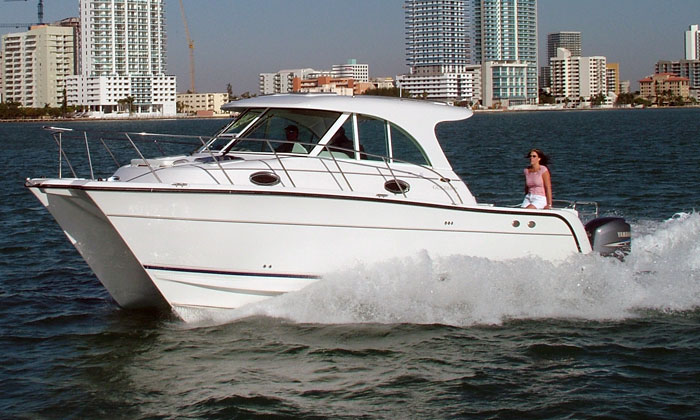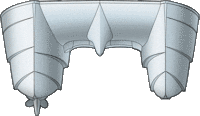How It All Started
A Letter from The Founder
To understand Aspen Power Catamaran’s goals and philosophy, you need a little history. My dad, Dave Graf, introduced me to boating and instilled in me a love of the outdoors. Throughout my youth we spent our summer vacations exploring, fishing, camping, and hiking in and around the San Juan Islands, the Washington Coast and Puget Sound. Our first boat trips were done in an 18-foot, plywood fiberglass cruiser that Dad built. Later, we moved up to a 24-footer, then a 26, and finally, to a 42-footer. The boats were our vehicles, and the fun was in the places we went and the things we did together. I remember getting up before sunrise to catch the morning bite, seeing the sun roll around and break through to melt the fog, hauling in salmon almost as big as me, and exploring small islands on a warm sunny day. These are the memories that last and shape my views of fun to this day.
At the age of 32, I realized that the entrepreneur in me had to escape. As a design engineer, I had developed more than 75 innovative consumer products for a variety of companies in the automotive, powerboat, and quality fitness equipment industries. My passion for engineering really took off in 1980 when I was studying at Western Washington University and joined the Viking Car Program where we designed and built aerodynamic cars that achieve fuel economy upwards of 100mpg, winning competitions around the country. All the books I had read on starting a company said to do it in an area in which you feel great passion. Deciding that boating was the field was easy, I had owned 17 boats myself by this point! Creating a new, special niche was more work. My underlying goal and thought process was that a better mousetrap was needed. I thought that if I could bring the ride, stability, and comfort of larger boats into a smaller, trailerable boat, that boaters would beat a path to my door.
Starting with a fresh outlook to solve the ride and comfort issues, the displacement, catamaran hull concept evolved. It was developed and tested over a six-month period with scale models in 1987. A full-scale engineering test boat was built in 1988 and the first Glacier Bay production catamarans were introduced in 1990 to a boating world that had no idea what it was.
Through the years of Glacier Bay, 1990 – 2007, the company grew to building 358 boats a year with 205 employees. We became the world’s largest cat builder with 35 dealers, and sales in 7 different countries globally.
In the fall of 2007, I began developing the next line of exceptionally efficient cruisers, “Aspen”. The design stemmed from the ability to operate Glacier Bays off one engine, but with slight counter steering. The concept of designing an asymmetrical hull shape then evolved, to correct for the offset thrust. I suspected that if I could design a full displacement catamaran that operated under one diesel inboard engine that the fuel efficiency would be unparalleled.
In the spring of 2008, I began constructing the first prototype with my son Nick. Like the first Glacier Bay prototype, this began in a small shop alongside my house. After months of development, we tested the first prototype with sea trials in September of 2008. The performance results of that first sea trial were astounding and surpassed what I initially thought was possible. By February 2009 we had dialed in the final details of the prototype hull and took the boat to the Miami International Boat Show. Two years later we would return and win the award for Innovation of the Year, competing against the world’s largest companies.
By January 2010 we had developed the first Aspen C90 Cruiser and displayed it at the Seattle Boat Show where we pre-sold 8 boats. Over the following three years we built 19 C90s in the 4,000 square foot shop alongside my house in Snohomish, Washington with a team of 7 employees. During this time, we partnered with Nordic Tugs out of Burlington, Washington for the fiberglass construction.
After listening to our customers express a desire for a larger cockpit and larger engine, we began developing the 32’ Aspen C100 in 2012. In January 2013 we debuted the C100 at the Seattle Boat Show where sales were amazing. The C100 offered a cockpit that was 4’ longer than the C90, higher tunnel clearance for a slightly softer ride, and a Volvo D3 220hp engine that provided higher cruise speeds.
It was also in 2012 that the design of the 40’ Aspen C120 began. Starting with drawings, and then eventually a full-size chipboard mockup.
In June 2014 my son Nick, friend Dave Boner and I embarked on the Pacific Challenge put on by Pacific Yachting magazine. On this trip we circumnavigated Vancouver Island non-stop traversing 557 miles, in 47 hours and 5 minutes, consuming only 267 gallons of diesel. To this day we hold the record.
At this stage, in 2014, the company had outgrown that 4,000 square foot shop alongside my house, so we moved production into Nordic Tug’s facilities in Burlington, Washington. It was also at this time that we began development and tooling on the next big step for Aspen, the 40’ Aspen C120. This 40’x14’ yacht hit the water in the spring of 2015. To our delight, we proved that the patented proa hull design scales beautifully, and in fact only gets better. As of the summer of 2022 there are 23 C120’s cruising the waters around the United States.
It was in the fall of 2015 that Aspen moved out of Nordic Tugs facilities after acquiring two new facilities of our own in Burlington, Washington with a total of 33,000 square feet at that time. This included both assembly and our own lamination building. By early 2016 the facilities were fully up and running.
Always having a thirst for adventure, from May 2017 to October 2018 we partnered with a new C120 owner to journey 10,502 miles from the Pacific Northwest to Annapolis, Maryland on an expedition we called the Aspen 10,000 Mile Tour. This voyage included cruising North to the glaciers of Alaska, before heading down the Pacific Coast, around the Baja Peninsula into the Sea of Cortez Mexico. The C120 was then portaged by truck to Texas where the journey continued across the Gulf of Mexico, through the Florida Keys, and up the eastern seaboard to arrive in Annapolis, Maryland for the 2018 Annapolis Boat Show. We averaged 19.5mph, getting an average fuel economy of 1.48mpg, and a top speed of 32mph surfing down the California coast (per the Garmin chartplotter).
In 2018 we won the Family Business Award for Innovation from Seattle Business Magazine. This was a really cool award… maybe the coolest. As an engineer in the innovation category, I don’t know if it gets any better than receiving an award for working with your family that you love. Today I work with my son Nick, Aspen’s Sales Director, my son Steve, the Financial Controller, and my son-in-law Brandon, the Service Manager.
Putting my engineering and design hat back on, we followed the market and Aspen’s first asymmetrical outboard powered hull launched in June 2018. This new design featured dissimilar powered outboards to match the asymmetrical hulls, with a 70hp on port and a 200hp on starboard. This new outboard design was applied to the C100, and the 34’ C107 was introduced the fall of 2018.
To prove the capabilities of this new outboard design I thought up a new, albeit crazy adventure. We decided to take the outboard prototype boat down the Mackenzie River in Canada to the Arctic Ocean in July 2019 in a promotion we called Aspen’s Arctic Adventure. This was an epic journey through the untamed Canadian wilderness, down an uncharted river 1,120 miles to the Arctic Ocean, and then back up the river to return to where we launched.
In the summer of 2020, we expanded operations even further, acquiring a 17,400 square foot building to be home for Aspen’s Service Department and a second lamination facility for the C120 line. By fall of 2021 we acquired another 5,000 square foot building for sub-assembly, across the street from our main assembly building.
Today, Aspen builds 7 models in a modern 48,000 square foot campus in the Pacific Northwest with a team of more than 44 skilled boat builders. The company has become quite successful, and I am very proud of our products, and our team including my family. I am also confident that if you have, or will be purchasing an Aspen Power Catamaran, you will be proud to own one of the most advanced and innovative boats available.
Larry Graf, Founder / Designer






































